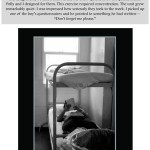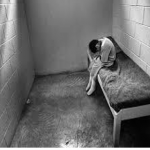Research shows prolonged solitary confinement can lead to depression, anxiety, and psychosis, and children are particularly vulnerable to these negative reactions because their brains are still developing, according to the American Academy of Child and Adolescent Psychiatry. Mental health professionals, advocates, and even many detention center administrators say the practice should be sharply curbed, if not eliminated.
Instead, staff at the Cook County Juvenile Temporary Detention Center, one of the largest juvenile jails in the country, regularly confine kids for hours at a time. Youth in the jail say it’s not uncommon for staff to threaten them with solitary for bad behavior.
Over the past two-and-a-half years, kids at the JTDC have been confined to their cells more than 55,000 times. Taken together, the time they’ve spent in solitary adds up to nearly 25 years.
The punitive use of solitary confinement at the JTDC has risen over the past two years, even as the population has shrunk 20%. There were 1,000 more punitive confinements in 2017 than in 2016, an increase of almost 25 percent.
Staff at the juvenile jail have confined kids for more than a day for damaging or failing to wear their identification wristband, up to 34 hours for exposing themselves, nearly three days for threatening someone, and up to 10 days for participating in a group fight.
State rules require juvenile detention centers in Illinois to limit room confinement to 36 hours, but they aren’t being enforced. Staff have kept kids in their room for longer than 36 hours in every month since May 2015, when Leonard Dixon took over the facility as superintendent. As recently as December 2017, staff confined two kids for more than 100 hours, while their fellow inmates got to spend extra time with their families for Christmas.
The Illinois Department of Juvenile Justice, which inspects county detention centers to make sure they’re compliant with the rules, can’t do anything even if they are non-compliant.
“Other than doing the audit, we have no real authority – no teeth to enforce anything,” said Heidi Mueller, who directs the state agency.
A growing consensus among experts is that juveniles should not be confined as a punishment for bad behavior. National standards from the Annie E. Casey Foundation say that solitary confinement should only be used as a temporary response to youth who are an immediate threat to themselves or others, and that as soon as they calm down, they should be returned to regular programming.
Overall, kids at the JTDC are being confined as punishment for shorter periods of time — the median confinement is about five hours, down from more than 10 hours in summer 2015 — but experts and advocates say even that is far too long.
Dixon, the superintendent, said solitary confinement is a necessary “behavior management tool” — he wouldn’t call it a punishment — and he doesn’t plan to stop using it:
Confinement is something that you use to ensure that your facility doesn’t get out of control. There are consequences for behavior. And we’re not going to run a facility where the kids can do whatever and you have an unsafe place.
But Mike Dempsey, director of a national organization of juvenile corrections administrators and the former head of Indiana’s juvenile justice agency, said staff who think using confinement makes a juvenile detention center safer are mistaken:
Kids come out of isolation more aggressive and more dangerous, often, than when they went into isolation. You shouldn’t use isolation as a disciplinary tool. Really, no good comes from it. You should avoid it at all costs.
The suicide of Kalief Browder in June 2015 brought the dangers of solitary confinement for teens into the national spotlight. Browder was arrested in the Bronx when he was 16 for allegedly stealing a backpack, and spent three years incarcerated on Rikers Island while awaiting trial, more than two of them in solitary confinement. Two years after the charges were dropped and he was finally released, he hanged himself.
Even before Browder’s death, experts had warned of the negative effects of locking kids and teens in their rooms. A February 2009 study by the U.S. Department of Justice found that about half of juveniles who committed suicide in custody from 1995 to 1999 were in solitary confinement at the time of their deaths.
Although little research has been done on the long-term effects of solitary confinement on young people, mental health experts suggest it can exacerbate existing trauma and mental illness. Roughly one-third of the teens in Cook County’s juvenile jail had a mental health diagnosis on an average day in 2016.
Mikah Owen, a pediatrician and assistant professor at the University of Florida College of Medicine in Jacksonville, said:
What we know now is that being exposed to trauma, especially at a young age, changes your body physiologically and changes your brain structure so that you’re more likely to respond more aggressively to certain stimuli. There is a developmentally appropriate way to address kids who are experiencing that, and that is not locking them in a cell.
The Council of Juvenile Correctional Administrators, Dempsey’s organization, which represents the heads of state-level juvenile correctional agencies, has recommended that juvenile facilities reduce solitary confinement. “There is no research showing the benefits of using isolation to manage youths’ behavior,” they noted in a 2015 report.
In 2016, President Barack Obama issued an executive order banning solitary confinement for juveniles in federal custody, but it was largely a symbolic move, since the vast majority of kids are incarcerated in state and local prisons and jails.
That same year, advocates launched the Stop Solitary for Kids campaign, which now has more than 50 supporting organizations, ranging from civil rights groups like the American Civil Liberties Union to the nation’s largest professional associations for correctional employees and administrators. States such as Massachusetts, California, and Colorado, and localities including New York, Los Angeles and Washington, D.C., have banned or severely limited solitary confinement for juveniles.
Cook County has gone in the opposite direction. In 2016, a team of juvenile detention experts from the Washington, D.C.-based Center for Children’s Law and Policy evaluated the facility for compliance with the Casey Foundation standards. They found the use of room confinement at the JTDC had increased “very substantially” since an earlier assessment in 2013.
In a strategic plan written in October 2016, the JTDC administration set a modest goal of reducing confinement by 2 percent over the next five years. Instead, the number of confinements has increased. There were 5,536 punitive confinements in 2017, up from 4,453 in 2016.
Illinois is among the states that have sharply limited solitary confinement as a punishment in its youth prisons, as part of an ongoing lawsuit with the ACLU. That leads to the ironic fact that a kid from Chicago can be confined to his cell for hours or days while awaiting trial at the Cook County detention center, when he is presumed innocent, but not once he is found guilty and sentenced to a state youth prison.
When Leonard Dixon took over the Cook County Juvenile Temporary Detention Center in May 2015, it was coming out from under federal court oversight. The facility had a history of overcrowding, mismanagement and awful conditions—including excessive use of solitary confinement—which had led the ACLU to file a lawsuit in 1999.
The largest category of punitive confinement – and the one that has increased the most since Dixon started – is for “unauthorized movement,” which the Center for Children’s Law and Policy noted could be something as small as stepping outside of the T.V. room.
The Center for Children’s Law and Policy has already told the JTDC to cut back on solitary confinement twice. It’s not clear why they expect the third time will be any different.
© Humane Exposures / Susan Madden Lankford; photo by Lankford




















